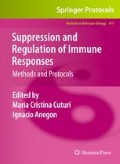Abstract
NKT cells are innate-like αβ T cells that are conserved between humans and mice. They are distinct from conventional T cells as they recognize lipid antigens presented by the CD1d molecule. Most NKT cells expressed a highly restricted TCR repertoire and can be activated by α-galactosylceramide (α-GalCer) and detected by α-GalCer-loaded-CD1d tetramers. Upon activation, NKT cells respond in few hours by producing cytokines and stimulating many other cells of the innate and adaptive immune system. Over the last decade, many studies have analyzed the regulatory role of NKT cells that can either suppress or exacerbate immune functions. This chapter describes the tools and techniques required to study in vivo and in vitro the regulatory role of NKT cells in mouse as well as from human blood.
Access this chapter
Tax calculation will be finalised at checkout
Purchases are for personal use only
References
Kronenberg, M. and L. Gapin (2002) The unconventional lifestyle of NKT cells. Nat Rev Immunol. 2(8): p. 557–68.
Bendelac, A., P.B. Savage and L. Teyton (2007) The biology of NKT cells. Annu Rev Immunol. 25: p. 297–336.
Mendiratta, S.K., W.D. Martin, S. Hong, et al. (1997) CD1d1 mutant mice are deficient in natural T cells that promptly produce IL-4. Immunity. 6(4): p. 469–77.
Cui, J., T. Shin, T. Kawano, et al. (1997) Requirement for Valpha14 NKT cells in IL-12-mediated rejection of tumors. Science. 278(5343): p. 1623–6.
Bendelac, A., R.D. Hunziker and O. Lantz (1996) Increased interleukin 4 and immunoglobulin E production in transgenic mice overexpressing NK1 T cells. J Exp Med. 184(4): p. 1285–93.
Lehuen, A., O. Lantz, L. Beaudoin, et al. (1998) Overexpression of natural killer T cells protects Valpha14- Jalpha281 transgenic nonobese diabetic mice against diabetes. J Exp Med. 188(10): p. 1831–9.
Duarte, N., M. Stenstrom, S. Campino, et al. (2004) Prevention of diabetes in nonobese diabetic mice mediated by CD1d-restricted nonclassical NKT cells. J Immunol. 173(5): p. 3112–8.
Skold, M., N.N. Faizunnessa, C.R. Wang, et al. (2000) CD1d-specific NK1.1+ T cells with a transgenic variant TCR. J Immunol. 165(1): p. 168–74.
Benlagha, K., A. Weiss, A. Beavis, et al. (2000) In vivo identification of glycolipid antigen-specific T cells using fluorescent CD1d tetramers. J Exp Med. 191(11): p. 1895–903.
Matsuda, J.L., O.V. Naidenko, L. Gapin, et al. (2000) Tracking the response of natural killer T cells to a glycolipid antigen using CD1d tetramers. J Exp Med. 192(5): p. 741–54.
Mars, L.T., A.S. Gautron, J. Novak, et al. (2008) Invariant NKT cells regulate experimental autoimmune encephalomyelitis and infiltrate the central nervous system in a CD1d-independent manner. J Immunol. 181(4): p. 2321–9.
Beaudoin, L., V. Laloux, J. Novak, et al. (2002) NKT cells inhibit the onset of diabetes by impairing the development of pathogenic T cells specific for pancreatic beta cells. Immunity. 17(6): p. 725–36.
Novak, J., L. Beaudoin, T. Griseri, et al. (2005) Inhibition of T cell differentiation into effectors by NKT cells requires cell contacts. J Immunol. 174(4): p. 1954–61.
Brossay, L., M. Chioda, N. Burdin, et al. (1998) CD1d-mediated recognition of an alpha-galactosylceramide by natural killer T cells is highly conserved through mammalian evolution. J Exp Med. 188(8): p. 1521–8.
Casorati, G., A. Traunecker and K. Karjalainen (1993) The T cell receptor alpha beta V-J shuffling shows lack of autonomy between the combining site and the constant domain of the receptor chains. Eur J Immunol. 23(2): p. 586–9.
Diana, J., T. Griseri, S. Lagaye, et al. (2009) NKT Cell-plasmacytoid dendritic cell cooperation via OX40 controls viral infection in a tissue-specific manner. Immunity. 30(2): p. 289–99.
Laloux, V., L. Beaudoin, C. Ronet, et al. (2002) Phenotypic and functional differences between NKT cells colonizing splanchnic and peripheral lymph nodes. J Immunol. 168(7): p. 3251–8.
Wei, D.G., H. Lee, S.H. Park, et al. (2005) Expansion and long-range differentiation of the NKT cell lineage in mice expressing CD1d exclusively on cortical thymocytes. J Exp Med. 202(2): p. 239–48.
Novak, J., L. Beaudoin, S. Park, et al. (2007) Prevention of type 1 diabetes by invariant NKT cells is independent of peripheral CD1d expression. J Immunol. 178(3): p. 1332–40.
Schumann, J., P. Pittoni, E. Tonti, et al. (2005) Targeted expression of human CD1d in transgenic mice reveals independent roles for thymocytes and thymic APCs in positive and negative selection of Valpha14i NKT cells. J Immunol. 175(11): p. 7303–10.
Abrignani, S., E. Tonti, G. Casorati, et al. (2009) B cell helper assays. Methods Mol Biol. 514: p. 15–26.
Author information
Authors and Affiliations
Editor information
Editors and Affiliations
Rights and permissions
Copyright information
© 2010 Humana Press
About this protocol
Cite this protocol
Diana, J., Beaudoin, L., Gautron, AS., Lehuen, A. (2010). NKT and Tolerance. In: Cuturi, M., Anegon, I. (eds) Suppression and Regulation of Immune Responses. Methods in Molecular Biology, vol 677. Humana Press, Totowa, NJ. https://doi.org/10.1007/978-1-60761-869-0_14
Download citation
DOI: https://doi.org/10.1007/978-1-60761-869-0_14
Published:
Publisher Name: Humana Press, Totowa, NJ
Print ISBN: 978-1-60761-868-3
Online ISBN: 978-1-60761-869-0
eBook Packages: Springer Protocols

